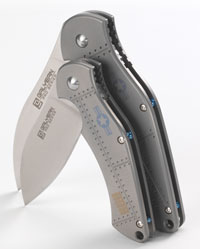At GunDigest, we independently review products. However, we may earn a commission when you purchase through links on our site. Learn More
Knife Spec: Who Let the Dawgs Out?
 Spec Chart Knives: Small and large |
Tim Galyean Customs and his Junkyard Dawg was a referral from a friend of mine. I am glad my friend introduced me to Galyean’s work. Though the knives boast a lot of CNC machining, Galyean does 95 percent of it himself in his shop. I wish I could run a CNC as well as he does.
The old-style aircraft design on the knife’s handle adds a touch of class.
Galyean sent me large and small versions of his Junkyard Dawg. As long as I had two knives, I played with both. I was hoping they would perform as well as they look.
Show Dawgs
After carrying the small Dawg around for a few days, I switched to its bigger brother for a few more. The small Dawg carries extremely light and secure and was very useful at doing standard day-to-day tasks. The big Dawg also carries light but takes up more room in a pocket, and is more usable than the small Dawg. Galyean’s CNC flat grind is outstanding on both knives. The edge geometry tapers to a thin edge, allowing very fine cuts.
I grabbed some half-inch plastic foam and cut it into half-inch strips. Next, using the folders like chef’s knives, I diced the foam. Both knives diced away without tearing the material, leaving a lot of thin slices sticking to every surface.
I moved on to some 8-to-9-ounce leather scraps. Both knives cut as if I were using scalpels. You could hear a little crunch as they slid through the leather. Thick or paper-thin cuts, both knives easily went through the medium. It was time to test those flat grinds!
I had my trusty cutting board set up with half-inch sisal rope. The small Dawg bit first—92 times through roughly 24 inches of sisal. What a nasty little Dawg! I bumped the rope size up to 1-inch manila. I stropped the edge twice on each side just to make sure it was in top shape. The small Dawg would almost make it through on a single cut but always left a little hanging on the backstroke. The knife still made 24 cuts in the manila.
It was time for the big Dawg to paw up. The half-inch sisal was like an appetizer to the large J.D. I went to 120 push cuts in record time. It needed something bigger to bite! Seventy-four cuts later on the manila and my arm was getting tight. The big Dawg loves to perform. Both knives are very comfortable cutting with a thumb on the side. However, the thumb grooves on top are a tad sharp when pressing down during use.
A friend gave me some scrap material for making large drive belts, about a quarter-inch thick with bands of cloth running through it. The knives slid through the rubber and cloth 30 and 40 times. Both beat a razor knife in cutting the material.
It was time to get the wood out. Some 1-inch pine boards needed whittling. The small Dawg made shapely curly-cues and was very controllable throughout. It would make a deep bite on the way in but, because of the blade’s size, I had to really pressure it out. The big Dawg was amazing on the pine—little bites or large ones, it did not matter. A flick of the wrist and it ate through the wood. Controlling the large blade of the big Dawg was a pleasure.
A wave of summer storms knocked downed some branches in the backyard. It was chowtime for the Junkyard Dawgs! The small Dawg, not much for chopping because of its size, took junior-sized bites from the branch. On the other hand, the big Dawg excelled at chopping. The shape of the blade and the knife’s overall balance made chopping a 3-inch-diameter branch a breeze.
Hanging Rope Cut
The author said the small Dawg cut through the 8-to-9-ounce leather scraps as if it were a scalpel. |
I took both knives to the shop to let my knifemaking partner, ABS journeyman smith Gary Wheeler, take a look. Even though we both like the small Dawg, the large Dawg made a bigger impression. Gary was playing with a William Scagel-style camp knife he had just completed, so I had to bet him whether he could cut the 1.25-inch hanging manila rope with a folder.
As he warmed up, he looked doubtful. All we heard was a snick, then Gary rubbing his shoulder. The big Dawg went through the rope fast, so Gary did not need to swing that hard. He finally got it right; a quick wrist snap and the big Dawg parted the hanging rope. Both of us were impressed. The flat grind is ideal for the hanging rope cut.
Recommendations
Soften the thumb notches some in case the user likes to cut with the thumb up.
More Bite Than Bark
Both Dawgs performed flawlessly. They are excellent knives for most any cutting job. I like the feel of the big Dawg best—it exhibits top-notch folder construction and is rock solid.
For more information contact Tim Galyean, Dept. BL12, 205 Bina Dr., Newberg, OR 97132 503.799.7779 www.galyeancustom.com.
You might also be interested in blademag.com.